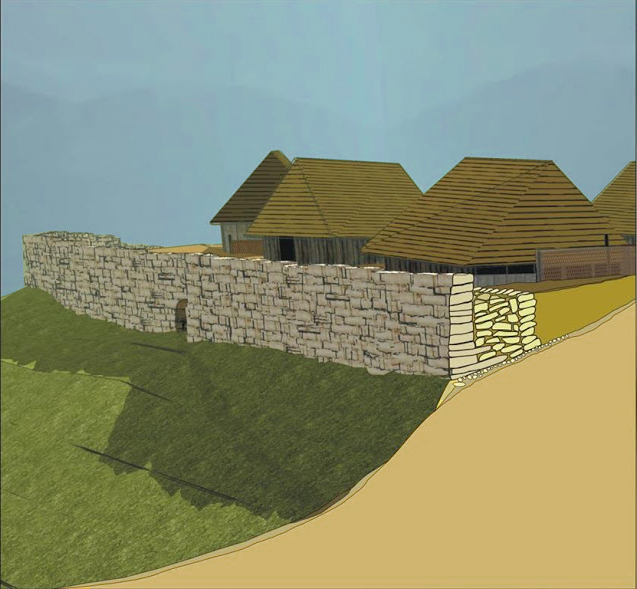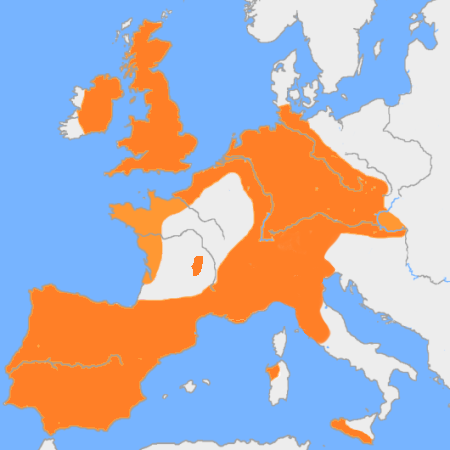|
Mad'arovce Culture
The Mad'arovce culture was an archaeological culture of the Early Bronze Age (c. 1750-1500 BC) located in western Slovakia. It formed part of the broader Mad’arovce- Věteřov-Böheimkirchen cultural complex, also found in Austria and Moravia, which had links with Mycenaean Greece. There was a gradual evolution from the preceding Únětice and Hatvan cultures to the Mad'arovce culture from c. 2000 BC to 1750 BC, and it was succeeded by the Tumulus culture after 1500 BC. The Mad'arovce culture is sometimes considered to be a sub-group in the final Únětice tradition. Important sites include the fortified settlements of Fidvár and Nitriansky Hrádok which are described as belonging to a 'Únětice-Maďarovce' archaeological horizon. See also * Únětice culture * Bronze Age Britain * Rhône culture * Armorican Tumulus culture * Polada culture * Ottomány culture * Unterwölbling culture * Wietenberg culture * Nordic Bronze Age The Nordic Bronze Age (also Northe ... [...More Info...] [...Related Items...] OR: [Wikipedia] [Google] [Baidu] |
Slovakia
Slovakia, officially the Slovak Republic, is a landlocked country in Central Europe. It is bordered by Poland to the north, Ukraine to the east, Hungary to the south, Austria to the west, and the Czech Republic to the northwest. Slovakia's mostly mountainous territory spans about , hosting a population exceeding 5.4 million. The capital and largest city is Bratislava, while the second largest city is Košice. The Slavs arrived in the territory of the present-day Slovakia in the 5th and 6th centuries. From the late 6th century, parts of modern Slovakia were incorporated into the Pannonian Avars, Avar Khaghanate. In the 7th century, the Slavs played a significant role in the creation of Samo's Empire. When the Avar Khaghanate dissolved in the 9th century, the Slavs established the Principality of Nitra before it was annexed by the Great Moravia, Principality of Moravia, which later became Great Moravia. When Great Moravia fell in the 10th century, the territory was integrated i ... [...More Info...] [...Related Items...] OR: [Wikipedia] [Google] [Baidu] |
Bronze Age Cultures Of Europe
Bronze is an alloy consisting primarily of copper, commonly with about 12–12.5% tin and often with the addition of other metals (including aluminium, manganese, nickel, or zinc) and sometimes non-metals (such as phosphorus) or metalloids (such as arsenic or silicon). These additions produce a range of alloys some of which are harder than copper alone or have other useful properties, such as ultimate tensile strength, strength, ductility, or machinability. The three-age system, archaeological period during which bronze was the hardest metal in widespread use is known as the Bronze Age. The beginning of the Bronze Age in western Eurasia is conventionally dated to the mid-4th millennium BCE (~3500 BCE), and to the early 2nd millennium BCE in China; elsewhere it gradually spread across regions. The Bronze Age was followed by the Iron Age, which started about 1300 BCE and reaching most of Eurasia by about 500 BCE, although bronze continued to be much more widely used than it is in ... [...More Info...] [...Related Items...] OR: [Wikipedia] [Google] [Baidu] |
Archaeological Cultures Of Europe
Archaeology or archeology is the study of human activity through the recovery and analysis of material culture. The archaeological record consists of Artifact (archaeology), artifacts, architecture, biofact (archaeology), biofacts or ecofacts, archaeological site, sites, and cultural landscapes. Archaeology can be considered both a social science and a branch of the humanities. It is usually considered an independent academic discipline, but may also be classified as part of anthropology (in North America – the four-field approach), history or geography. The discipline involves Survey (archaeology), surveying, Archaeological excavation, excavation, and eventually Post excavation, analysis of data collected, to learn more about the past. In broad scope, archaeology relies on cross-disciplinary research. Archaeologists study human prehistory and history, from the development of the first stone tools at Lomekwi in East Africa 3.3 million years ago up until recent decades. A ... [...More Info...] [...Related Items...] OR: [Wikipedia] [Google] [Baidu] |
Nordic Bronze Age
The Nordic Bronze Age (also Northern Bronze Age, or Scandinavian Bronze Age) is a period of Scandinavian prehistory from . The Nordic Bronze Age culture emerged about 1750 BC as a continuation of the Late Neolithic Dagger period, which is rooted in the Battle Axe culture (the Swedish-Norwegian Corded Ware variant), the Single Grave Culture (the north German and Danish Corded Ware varaiant) and Bell Beaker culture, as well as from influence that came from Central Europe. This influence most likely came from people similar to those of the Únětice culture, since they brought customs that were derived from Únětice or from local interpretations of the Únětice culture located in North Western Germany. The metallurgical influences from Central Europe are especially noticeable. The Bronze Age in Scandinavia can be said to begin shortly after 2000 BC with the introduction and use of bronze tools, followed by a more systematic adoption of bronze metalworking technology from 175 ... [...More Info...] [...Related Items...] OR: [Wikipedia] [Google] [Baidu] |
Wietenberg Culture
The Wietenberg culture was a Bronze Age Europe, Middle Bronze Age archeological culture in central Romania (Prehistory of Transylvania, Transylvania) that roughly dates to 2200–1600/1500 BCE. Representing a local variant of Usatove culture, it was contemporary with the Ottomány culture and Unetice culture and was replaced by the Noua-Sabatinovka-Coslogeni complex, Noua culture. Its name was coined after the eponymic Wietenberg Hill near Sighișoara. People of this culture traded with the Mycenaeans. Burial sites contain bronze battle axes and maces with stone heads. Pottery consists of amphorae with spiral and meandric ornament. By 1964, about 200 settlements of this culture were discovered. Gallery File:Wietenberg culture axes at National Museum of Transylvanian History 2007.jpg, Battle axes from Valea Chioarului, Maramureș County (National Museum of Transylvanian History in Cluj) File:Wientenberg gold bracelet 2.jpg, Gold bracelet (from pre-WWI book plate) File:Wiete ... [...More Info...] [...Related Items...] OR: [Wikipedia] [Google] [Baidu] |
Unterwölbling Culture
The Unterwölbling culture is an Early Bronze Age culture that thrived between 2300 and 1800 BCE in the region roughly bounded by the Danube, the Lower Austrian Alpine foothills, the Enns River, and the Vienna Woods. The main localities are in the lower parts of Danube tributaries, including the Enns, Ybbs, Melk, Fladnitz, Traisen, and Great Tulln. This culture probably originates from the Late Neolithic Bell Beaker culture and was subsequently replaced by the Böheimkirchen (Věteřov) culture. The name was coined in 1937 by Richard Pittioni after the site of Unterwölbling, a small town in present-day municipality of Wölbling in Lower Austria, about 1.5 km northwest of Oberwölbling. The Unterwölbling culture made their metal products primarily from forged sheet metal and decorated them with dots. Remains of leather caps held/decorated by strips of bronze sheet metal have been found as grave goods in women's graves. The jewelry attributed to this culture also included ch ... [...More Info...] [...Related Items...] OR: [Wikipedia] [Google] [Baidu] |
Ottomány Culture
The Ottomány culture, also known as Otomani culture in Romania or Otomani-Füzesabony culture in Hungary, was an early Bronze Age culture (–1400 BC) in Central Europe named after the eponymous site near the village of Ottomány (), today part of Sălacea, located in modern-day Bihor County, Romania. The Middle Bronze Age period of the Ottomány culture in eastern Hungary and western Romania ( to 1400 BC) is also known as the Gyulavarsánd culture. Territorial extent The Ottomány culture was located in eastern Hungary, eastern Slovakia, Crișana in western Romania, western Ukraine - Transcarpatia (Zakarpattia Oblast - within a stretch of the Carpathian Mountains) and southeast Poland (stretch of Carpathian Mountains and nearby areas). Thus, people of the Ottomány culture secured a middle stretch of what will be later known as the Amber Road, and indeed, amber is often found in Ottomány sites. The expansion of the Ottomány culture is associated with the end of the Hatvan ... [...More Info...] [...Related Items...] OR: [Wikipedia] [Google] [Baidu] |
Polada Culture
The Polada culture (22nd to 16th centuries BCE) is the name for a culture of the ancient Bronze Age which spread primarily in the territory of modern-day Lombardy, Veneto and Trentino, characterized by settlements on pile-dwellings. The name derives from the small Polada peat bog (''Stagno della Polada'') in Lombardy, between Lonato del Garda, Menasasso, and Desenzano del Garda. The first findings attributed to this culture were discovered in the years between 1870 and 1875 as a result of intense activities of reclamation in that bog, and were collected by Giovanni Rambotti. The dating of carbon-14 on the finds place them between c. 1380 BCE and c. 1270 BCE. Other major sites are found in the area between Mantua, the Lake Garda and the Lake of Pusiano. It was succeeded in the Middle Bronze Age by the facies of the pile dwellings and of the dammed settlements and the Terramare culture. Chronology The Polada culture is usually assigned to the period from 2200 to 1500 BCE ... [...More Info...] [...Related Items...] OR: [Wikipedia] [Google] [Baidu] |
Armorican Tumulus Culture
The Armorican Tumulus culture is a Bronze Age Europe, Bronze Age culture, located in the western part of the Armorican peninsula of France. It is known through more than a thousand burial sites covered by a tumulus or otherwise. The culture is renowned for some exceptionally richly endowed burials of chieftains of the time, which are contemporary with the elite of the Wessex culture, in England, and the Únětice culture, in Central Europe. The extensive documentation of this funerary archaeology has been supplemented by the discovery of various types of habitat (dry stone houses, open air habitats, monumental enclosures, etc.) Overview The Armorican Tumuli refer to individual burials of the Bronze Age that can be covered by a tumulus in the western part of the Armorican peninsula of France, in a region commonly called Lower Brittany. Not all the tumuli of Brittany belong to the Armorican Tumulus culture. Older tumuli in the area date from the Neolithic Europe, Neolithi ... [...More Info...] [...Related Items...] OR: [Wikipedia] [Google] [Baidu] |
Rhône Culture
The Rhône culture was an archaeological culture of the Early Bronze Age (-1500 BC) located in eastern France and western Switzerland, centred along the Rhône river. The culture developed from the local Bell Beaker culture, possibly with further migrations from central Europe. According to Sergent (1995) the Rhône culture represents a southern variant of the Unetice culture. Rhône culture metalwork and pottery are particularly similar to those of the Straubing group in Bavaria. Artefacts and characteristics The Thun-Renzenbühl axe (), found near Thun and attributed to the Rhône culture, is one of the earliest examples of the use of damascening technique in the world. The gold inlay decoration on the axe may also have a numerical, astronomical meaning. Gallery File:Rhodanian knife-MGR Lyon-IMG 9738.jpg File:Poignard et hache en bronze - Solliès Pont - Var.jpg File:Vollgriffdolch von Döttingen.jpg File:Età del bronzo arcaica, pugnali, 2200-1600 ac ca..JPG File:Rhon ... [...More Info...] [...Related Items...] OR: [Wikipedia] [Google] [Baidu] |
Bronze Age Britain
Bronze Age Britain is an era of British history that spanned from until . Lasting for approximately 1,700 years, it was preceded by the era of Neolithic Britain and was in turn followed by the period of Iron Age Britain. Being categorised as the Bronze Age, it was marked by the use of copper and then bronze by the prehistoric Britons, who used such metals to fashion tools. Great Britain in the Bronze Age also saw the widespread adoption of agriculture. During the British Bronze Age, large megalithic monuments similar to those from the Late Neolithic continued to be constructed or modified, including such sites as Avebury, Stonehenge, Silbury Hill and Must Farm. That has been described as a time "when elaborate ceremonial practices emerged among some communities of subsistence agriculturalists of western Europe". History Early Bronze Age (EBA), c. 2500–1500 BC There is no clear consensus on the date for the beginning of the Bronze Age in Great Britain and Ireland. Some ... [...More Info...] [...Related Items...] OR: [Wikipedia] [Google] [Baidu] |









